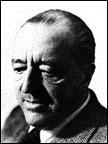Mies van der Rohe
 Born in Aachen, Germany, Ludwig Mies van der Rohe (1886-1969) initially worked as a draftsman specializing in furniture design and rendering. After working with progressive German architect Peter Behrens, Mies opened his own office in 1914. He soon achieved international recognition as one of the leading figures of modern architecture, through such works as the German Pavilion at the 1929 International Exposition in Barcelona, Spain, and the Tugendhat House in Brno, Czechoslovakia. He also established a reputation in the field of architectural education, having been affiliated with the famed Bauhaus school of design in Germany. He served as its director from 1930 to 1933, when the political pressures of Nazi Germany forced its closing.
Born in Aachen, Germany, Ludwig Mies van der Rohe (1886-1969) initially worked as a draftsman specializing in furniture design and rendering. After working with progressive German architect Peter Behrens, Mies opened his own office in 1914. He soon achieved international recognition as one of the leading figures of modern architecture, through such works as the German Pavilion at the 1929 International Exposition in Barcelona, Spain, and the Tugendhat House in Brno, Czechoslovakia. He also established a reputation in the field of architectural education, having been affiliated with the famed Bauhaus school of design in Germany. He served as its director from 1930 to 1933, when the political pressures of Nazi Germany forced its closing.
In 1938, the Armour Institute of Technology, a modest technical training school on Chicago's near South Side, engaged Mies to take over its architectural program. He also established his own independent architectural practice, and his first client proved to be the school itself, which had merged in 1940 with Lewis Institute to form the Illinois Institute of Technology. Mies helped develop a comprehensive master plan for the campus and designed nearly 20 individual buildings, which comprise the largest and most important collection of Mies buildings anywhere. He also designed dozens of other internationally significant buildings, including the Seagram Building in New York, the Farnsworth House in Plano, IL, and the Federal Center in Chicago.
Mies ranks as one of the most notable architects of the 20th century. With his highly developed sense of classical proportion, appreciation of modern structure and materials, and keen sense of craftsmanship, he created buildings that provided a new style for the 20th century, one that reshaped architecture following World War II. The street in front of Chicago's Museum of Contemporary Art, near Mies' former residence, is named in honor of the architect.